Effective project management can make or break a startup’s success.
As a startup founder, you’re pulled in lots of different directions. You’re the CEO, the marketing guru, the head of sales, and the entire HR department. It’s tough to add “project manager” to that list of responsibilities.
The more your business grows, the harder it gets to take projects across the finish line.
Even if a dedicated project manager isn’t in the budget, you can’t afford to keep operating without a strategy. Organizations report that 67% more of their projects completely fail when they underestimate their project management needs.
The good news is that you don’t need to hire (or become) a professional project manager to get things done.
The more your startup grows, the harder it gets to take projects across the finish line.
You can get more done and grow faster with some basic understanding and the right tools. As your business grows and becomes more complex, you’ll have more resources to bring on a dedicated project manager.
This article will help you get started.
Boost your team’s efficiency with Hubstaff's productivity tools
The importance of project management for startups
As a startup, your resources are limited. You can’t afford to waste time or money. A good project management strategy saves both by making it possible to get more done in less time.
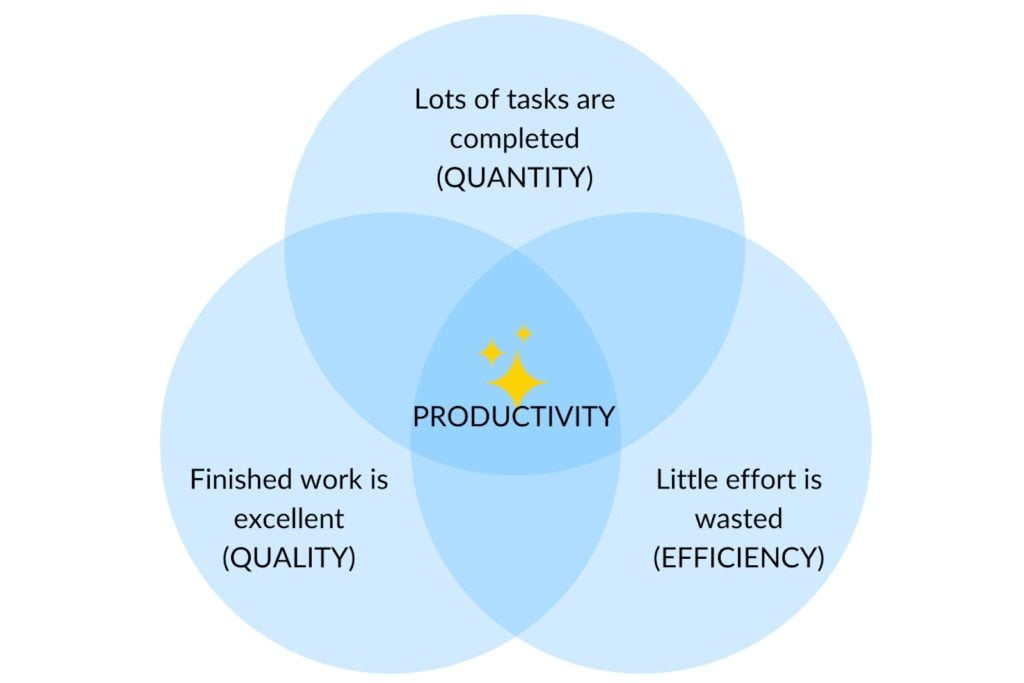
With good project management habits, it’s easier to keep costs low. You get things done sooner and spend less on labor. If your budget starts to creep, you spot it earlier and can step in before it becomes an expensive problem.
A good project management system makes it more likely that your startup will succeed.
Communication improves, too. This is a major benefit for startups because communication issues are so expensive.

Effective project management keeps your team connected so that everyone focuses on the right priorities at the right times. Your people can find the information they need, and you can trust that the most important tasks will get done on time.
Here’s the most important thing:
The right project management strategy makes you more likely to succeed.
With the right project management methodology, you get your products to market faster and spend less of your resources to do it. You learn faster. If you need to pivot to serve your customers or beat the competition, you can adjust more quickly and waste less money doing it.
Small productivity leaks and budget overruns eat away at your already limited resources. The problems might not be obvious, but they can still be the reasons your startup fails.
Start managing projects wisely now so that you’re prepared for your next big growth spurt.
How to manage projects in a startup
Before we take a deeper look at project management methodologies, you have a decision to make.
Are you going to hire a project manager, or will you manage projects for your team?

By hiring a project manager, you’re likely to get better results sooner. If you already struggle to get work done and products shipped, this might be your best choice.
Be mindful of budget. A good project manager helps your startup make more money. It’s up to you to determine if they’ll help you improve enough to pay their salary. If you only have a few projects to manage right now, you may be wise to wait.
Managing your own projects is tough, but doable.
Whether you hire a project manager or not, it’s a good idea to use specialized software to help you stay on top of things. Modern project management tools are easy to use, and most of them are very affordable for startups. Depending on your team size, you may be able to use a great tool for free.
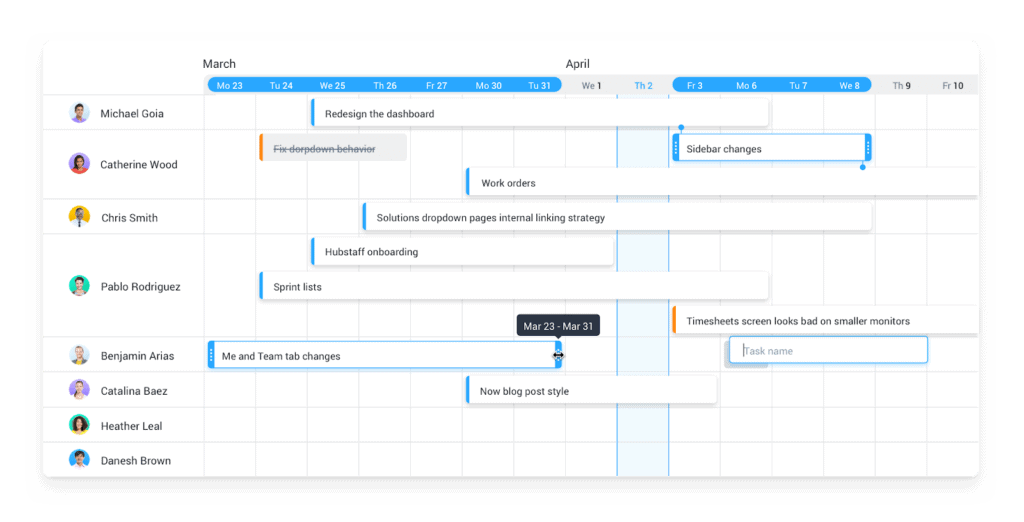
Managing your own projects is tough, but doable. Have the discipline to stick with it. Building new habits takes time.
As a startup founder doing your own project management, consistency will be one of your biggest challenges.
You and your team need to commit to your new processes, and it’s up to you to help everyone build new habits. If you only do it sometimes, your project management strategy will create more work and frustration. Instead of helping you use your resources more efficiently, a half-hearted approach will become a drain.
With that in mind, here are some tips to help you choose the right methodology for your startup.
1. Choose a project management methodology
A project management methodology is just a system that your team uses to keep work organized. When everyone follows the same rules, it’s much easier to work as a team.

There are a lot of project management styles out there, and they all have pros and cons. As you get more comfortable managing projects, you can create your own hybrid approach to suit the way your startup works.
To help you choose the best methodology, answer these questions about your startup:
- How big is your team now?
- How much do you expect your team to grow in the next 5 years?
- How complex are your projects?
- How many projects do you need to manage at the same time?
- Do your employees need to communicate often, or do they work more independently?
- What resources do you have available now, and how will that change as you grow?
- Are most of your projects similar, or do you need to manage different kinds of work for different departments?
Think about what you need now and what you expect for the future. Even companies with a single product may have more complex project needs as they scale.

For example, Hubstaff is a software company. Our developers focus more on improving our existing products instead of creating lots of new ones.
We also have a marketing department, a growing sales division, and an excellent support team. Each of these departments needs to manage projects, too.
A company like ours needs to manage a lot of different projects that vary in complexity and size. We work independently, so we rely heavily on our project management system to communicate. As we grow, we need our project management methodology to help us stay connected and efficient.
Kanban works great as our overall methodology. This approach gives us the structure we need to stay on track and the flexibility to manage a lot of different types of projects within the same system.
Let’s talk about the most popular project management styles so you can find the best fit for your startup.
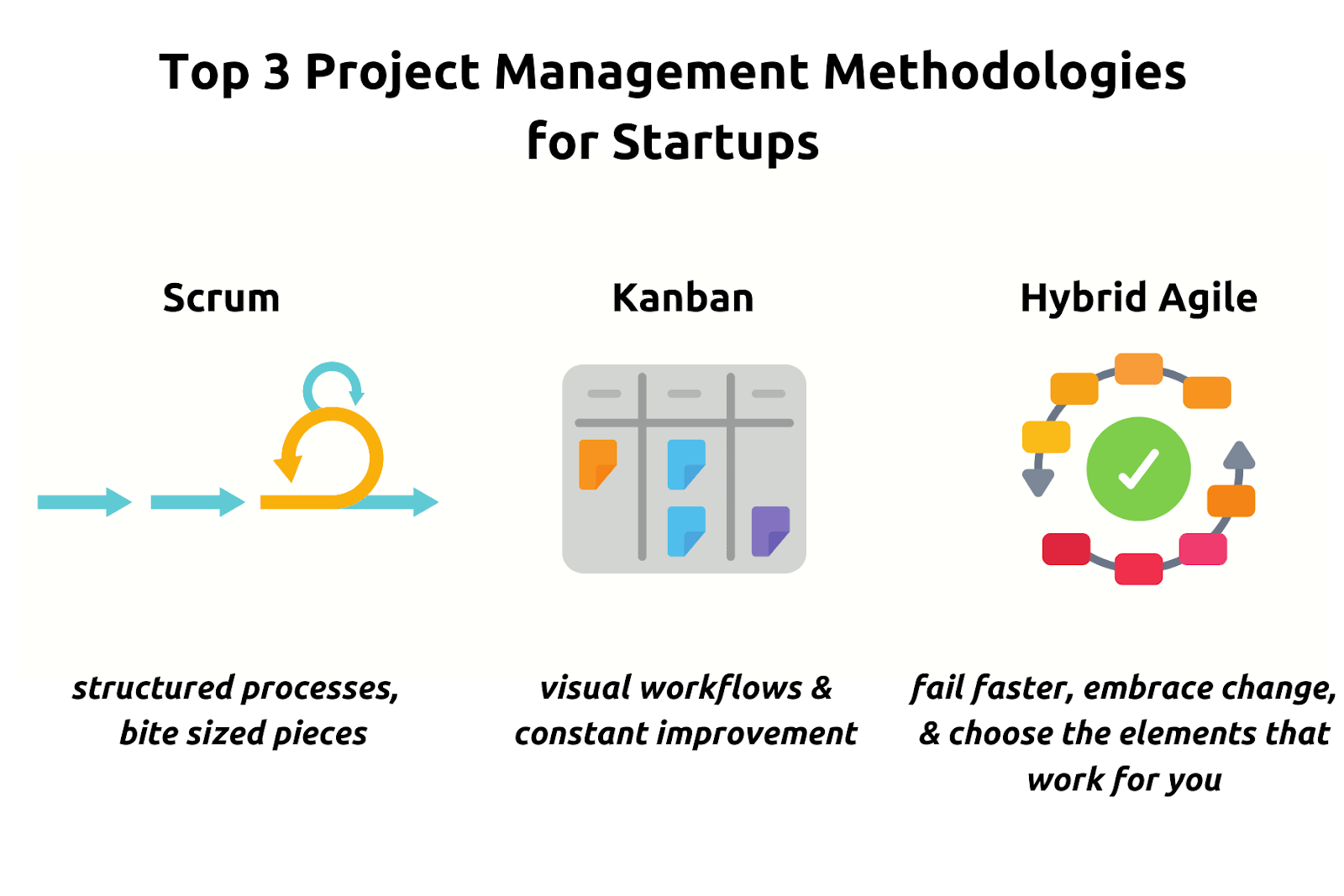
Agile
When you look at the principles behind agile project management, it’s ideal for startups. This methodology was developed for software teams and is now popular in a lot of industries.
Agile focuses on flexibility. In Agile project management, the goal is to finish a working project as quickly as possible, then iterate on that design to improve it.
This process is guided by four principles:
- Individuals and interactions over processes and tools
- Working software over comprehensive documentation
- Customer collaboration over contract negotiation
- Responding to change over following a plan
This is a great methodology for companies that struggle with perfectionism. In Agile, you’re not trying to create the perfect product immediately. The goal is to finish something that works, get it out there, and then use the money you make on that first iteration to help fund improvements.

Agile is more of a mindset and set of values than a methodology. Many other methodologies use the Agile framework.
Often, companies take a hybrid approach to Agile project management. Instead of using Kanban, Scrum, or specialized approaches like Extreme Programming (XP), you can choose the elements that work best for you to create a custom system. That means you can host Scrum-style standups while tracking progress on a Kanban board.
Pros: The often unpredictable nature of running a startup requires teams to be flexible. Agile gives you the chance to learn and adapt without risking a huge investment. Rather than building products that you think the consumer wants, you can build products based on actual user feedback.
Cons: Sometimes, what startup teams need is more structure, not less. Agile project management can allow too much wiggle room so teams stray too far from the original concept.
Manage projects with ease
Use Hubstaff Tasks to manage projects, balance workloads, and meet deadlines consistently.
Scrum
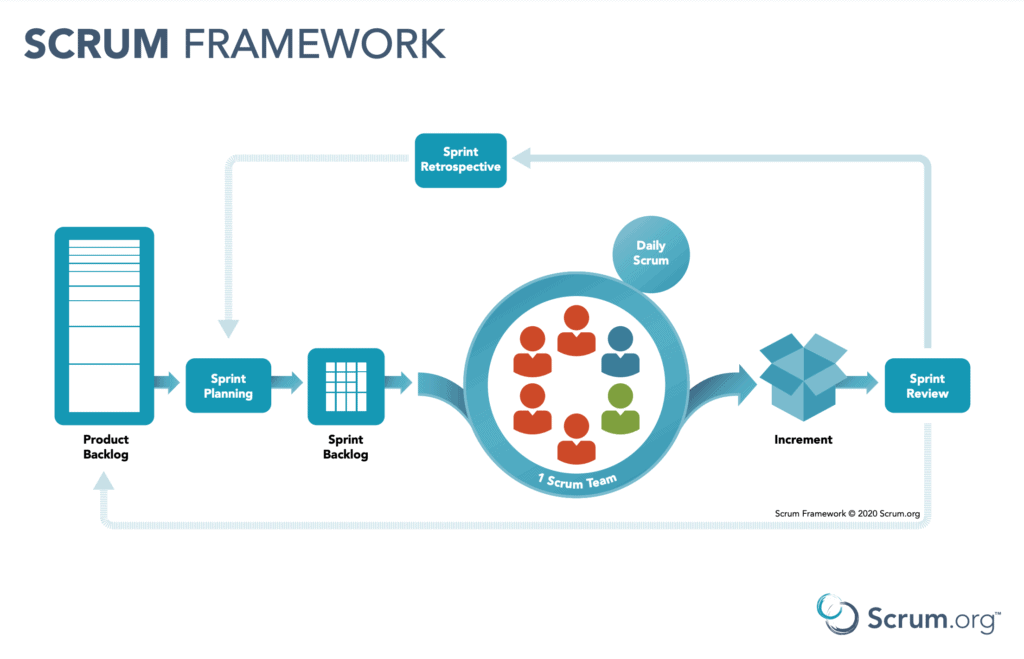
Like Agile, Scrum was originally designed for software development. It’s still a popular choice for developers, though other types of teams have used this methodology successfully.
This project management style relies on a Scrum Master and a Product Owner. The Scrum Master makes sure that the team is following Scrum principles. The Product Owner is in charge of the Project Management Backlog and is accountable for the finished product. These roles can sometimes be fulfilled by the same person.
The Scrum process is very structured. Work is placed in the Product Backlog or the Sprint Backlog. Sprints are a short, specific period of time (like one week) for team members to focus on their goals.
The Product Backlog is the list of all the tasks that need to be completed in order for this project to be finished.
The Sprint Backlog is like a to-do list. It’s the list of tasks that an individual employee needs to complete during this Sprint.
Each day, Scrum teams use Standups to communicate and stay connected. During a standup, each person gives a quick summary of what they finished, what they plan to do next, and anything that’s standing in the way.
If you’re thinking about adopting Scrum, it’s a good idea to work with a certified Scrum Master. Otherwise, you can use elements of this methodology in conjunction with another project management style.
Pros: Even if startups aren’t in the software industry, the concept of having daily stand-ups and working in “sprints” is particularly suited to the startup environment. Scrum can help startup teams become more self-sufficient. Regular reviews can help startups diagnose problems early and solve them quickly.
Cons: To use Scrum effectively, you should have a dedicated Scrum Master and Product Owner. This makes it less budget friendly, especially for small teams.
Kanban

Kanban methodology comes from the world of manufacturing. It’s a Lean ideology, which means that the main goal is to eliminate waste.
There are four core principles on which Kanban was built.
- Start where you are. You shouldn’t have to make massive changes to the way you work to use Kanban. Layer these practices on top of your existing workflow so you can keep doing the things that already work well and improve the things that don’t.
- Aim for gradual, steady improvement. This process of constant improvement is called Kaizen. Your team will be less resistant to change when you ask for small tweaks instead of big shifts. This makes new processes more sustainable.
- Keep your current processes and team structure. There’s a reason you hired your employees for specific roles, and you should keep that. You shouldn’t have to change responsibilities to fit your project management method.
- Encourage leadership at all levels. Everyone on your team is responsible for driving improvements. Kanban doesn’t work if only management cares.
These principles drive the six core practices of Kanban.
- Visualize workflows – This is where the popular Kanban board comes in. Each task is put on a Kanban card. Cards are placed in columns that show you where it is in the workflow.
- Balance workloads – If employees can have an unlimited amount of tasks in their to-do list, you’re not doing Kanban. Work-in-progress limits force you to prioritize tasks and keep workloads manageable.
- Manage work, not people – Instead of micromanaging your employees to get more done, Kanban focuses on creating better workflows and processes. Your job is to make sure work can flow through the process.
- Publish your process – All of your processes and procedures should be totally clear. Your entire team should know the end goal and where they fit. This makes room for leadership at all levels.
- Create feedback loops – Communication is important. Kanban uses daily standups to keep team members connected. You can also implement service delivery reviews, operations reviews, risk reviews, and other types of meetings to find opportunities to improve.
- Improve continuously – It’s everyone’s job to find ways to make small improvements. Collaborate and improve as a team.
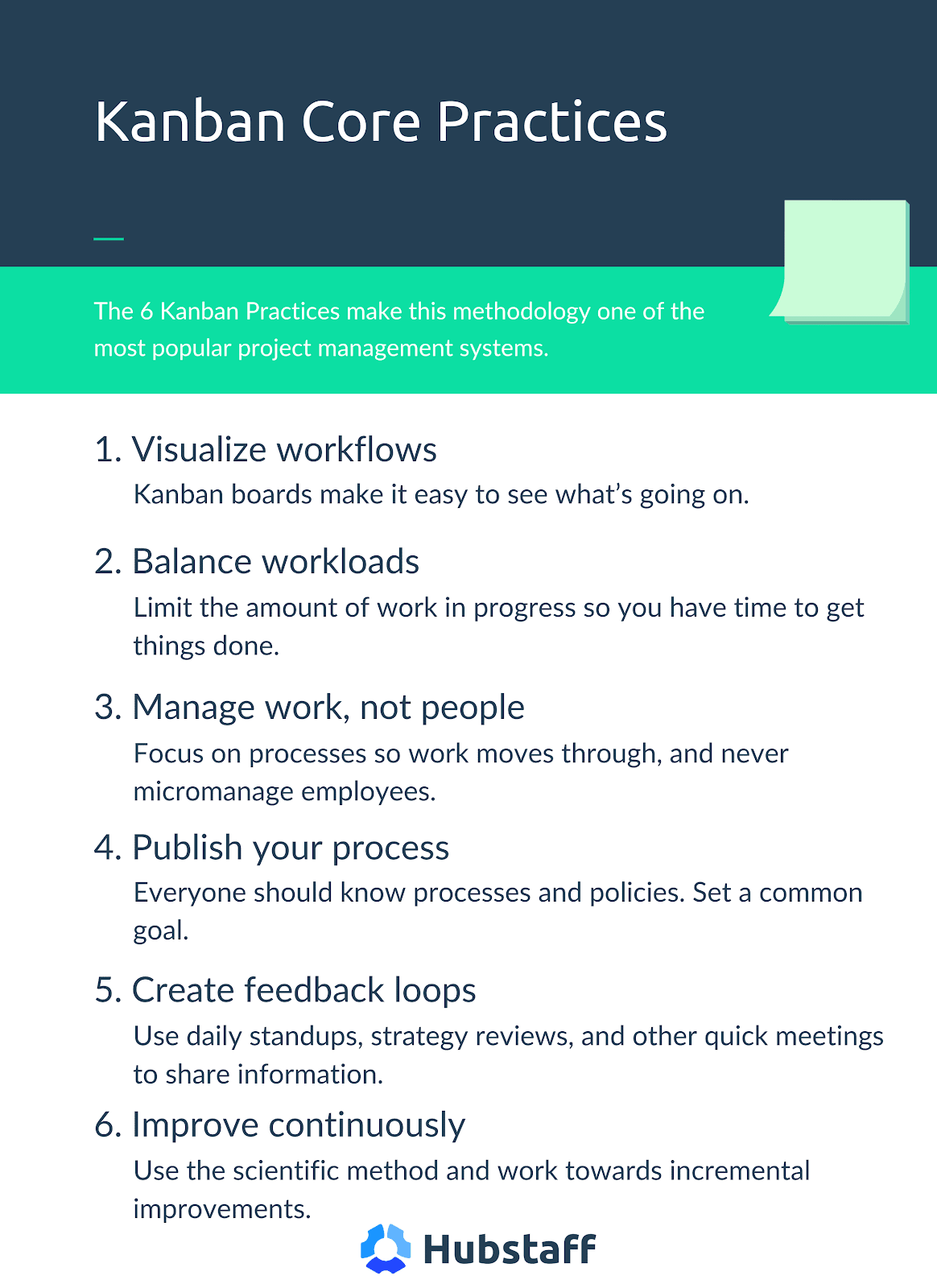
You probably recognize the popular Kanban board setup.
Using a visual workflow tells you what has already been done, what is still left to do, and who’s working on what. If there are bottlenecks, they’re easy to spot. Your team can see what’s coming down the pipeline and plan their work more efficiently.
Tools like Hubstaff Tasks can automate this process to make it even easier.
Kanban is designed to work well with whatever systems you already have. Rather than replacing your workflow, this methodology fits in and helps you make it better over time.
Pros: Kanban is simple and powerful. It helps unstick your workflow hangups and spot problems ahead of time. For startups, the principle of leadership at all levels works especially well.
Cons: Kanban is built around your existing system and focuses on slow, steady change. If you need to make big changes right away, you might struggle with this system at first.
2. Create a startup project plan
How do you handle projects at your startup? If you’re used to figuring it out as you go along, it’s time to upgrade your process.
Each project you launch starts with a planning phase. As you transition your current projects to your new project management system, you may need to revisit the plan for some. Figure out how you’re going to tackle project planning before you start the transition.

Planning is one of the most important steps in project management. It should happen for every project. This is the phase when you answer questions like:
- Where does this fit with other priorities?
- Who needs to work on this, and what else are they already doing?
- Are your goals for this project realistic?
- Can you meet your deadline?
When you do this for every project — even the small ones — you’ll have an easier time getting the most important things done. Without a plan, your team will bounce between tasks as more to-dos get added to the list. Planning is the step that makes project management work for your startup.
Planning is one of the most important steps in project management. Do it for every project.
You can speed up the planning process by using workflow templates for things you do frequently. For example, if you maintain a company blog, the process for each post is the same. Your workflow template will tell you all the steps you need to plan and help you get everything done before the publish date.
Every project is different, but planning goes through the same steps.
Agree on the end goal
Before anyone starts work, everyone needs to know what you want to accomplish.

For some projects, you may need to talk to any stakeholders or investors. Major product updates, for example, have a big impact on your business. These projects should wait until all stakeholders agree so you don’t face resistance after you’ve already invested resources.
Give your employees a chance to weigh in, too. They can tell you if your goals are unrealistic or if they conflict with other projects that are already underway.
During this stage of project planning, list the deliverables you expect and agree on the quality standards you’ll use to judge success.
Define roles

This step will vary a little depending on the project management methodology you choose for your startup.
If you use Scrum, this is the step where you assign your Scrum Master and Product Owner. They can help you build the Scrum Team and break down responsibilities from there.
You might assign a single person who is accountable for this project’s success or failure. They can delegate work or assign other roles as needed.
For companies that use Kanban workflows, roles are often defined by steps in the process.
Project responsibilities can be flexible. What’s most important during planning is that you determine who you need on this project so that you can make room in their schedule.
Draft a project timeline
When can you deliver? During this step, map out your project milestones and set due dates.
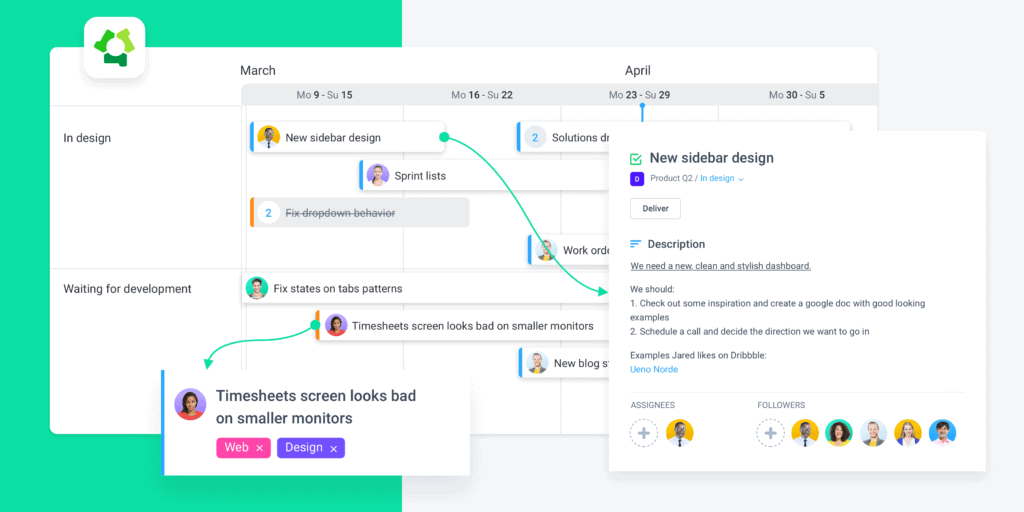
Keep in mind that your team is working on lots of other things. Due dates need to be realistic and should reflect the project’s priority.
New projects may be more important than things that are already underway. If that’s the case, you’ll also need to adjust existing timelines for other projects during this step.
Set your budget
Project budgets are easy to overlook.
You might not think it’s important to set a budget when you’re not spending any money, but remember that labor costs are one of your biggest expenses.
Consider your project goals. A new web page design might be worth the investment at 25 hours of work, but not at 50. With a budget in place, you can tell which projects are on the way to meeting their goals and which might need your attention.
When your project management plan is solid, you’re ready to start your transition.
Project management software for startups
Get your startup’s projects done on time with Hubstaff Tasks.
3. Move your existing projects to your new system
If it’s your first time using a project management system, this part is the most intimidating. How do you take all the things your team is already working on and move them to a whole new system?
It’s a lot, but it’s not as difficult as it sounds. Tackle this task in bite sized chunks.
Follow the steps here to make it a lot easier.
Take inventory
Your team is already working on a lot of different things. Can you list all of those projects and their current status off the top of your head?
Probably not.
Fortunately, you don’t have to. This is a team activity.
You don’t have to move everything at once. Tackle big projects like this in bite-sized chunks.
Ask each of your employees to list the tasks in their to-do list right now. Include things that they’re actively working on and things that they haven’t gotten to yet. Remember recurring tasks like quarterly reporting and monthly newsletters, too.

Set a deadline. Allow your team to work on their list over a few days so they can add items as they go. But if you don’t make this a priority, it won’t get done. You can always add missed items later.
This exercise has an added bonus. Companies that don’t use a project management system often have problems with tasks slipping through the cracks. The lists your team members make will show you what you’ve missed and where you need to communicate better.
Organize tasks by project
Good project management helps you see how things fit together. That makes it much easier to get things over the finish line.
Many of the tasks your team is working on are smaller pieces of a shared goal. Those tasks are all part of the same project.

For example, let’s say your team’s task lists look like this:
Software developer tasks:
- Implement product updates for Q2
- Update the design for the Promo A landing page
- Build a new landing page for Promo B
- Respond to bug tickets
Quality assurance tester tasks:
- Review the landing pages for both Promo A and Promo B
- Perform quality checks on weekly marketing emails
- Manage the bug tracker and assign tickets to developers
- Test new product features as they’re completed
Marketing lead:
- Write ad copy and landing page copy for Promo B
- Design and write copy for the weekly marketing emails
- Plan marketing campaigns around the new Q2 features
Social media lead:
- Engage with followers on social media by responding to comments and messages
- Monitor the performance of social media ads for Promo B
- Filter messages for complaints and forward bugs to the QA team
Based on these task lists, the larger projects on your list are:
- New product features for Q2
- Promo A
- Promo B
- Weekly emails
- Social media engagement
In this example, only the social media lead works on engagement, but everyone works on Promo B. That’s normal. Some projects involve more tasks than others, and some projects might just be a single task.
With your project list in hand, you’re ready for the next step.
Map workflows
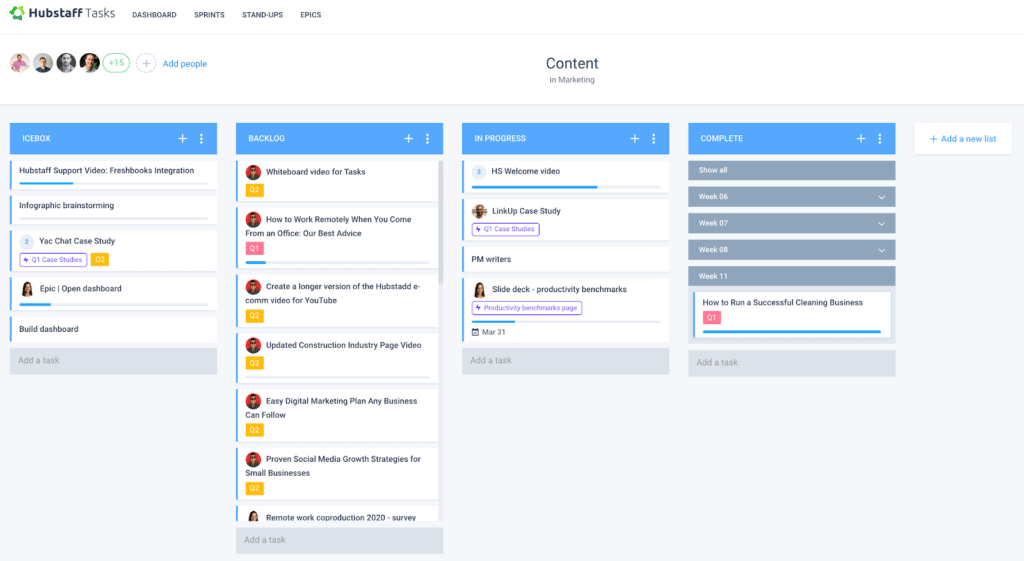
You have a list of active projects. You have lists of tasks. Now, put those tasks in order so you can see what a project looks like from beginning to end.
Mapping workflows does two important things:
- It organizes your projects so you can manage them more effectively, and
- It shows you all the places where you could use improvement.
You’ll find it much easier to spot the reasons that work isn’t flowing the way you want it to. Maybe the hand-off between team members isn’t as smooth as you thought. There are probably bottlenecks where someone has too many items on their list to get through everything.
It’s tempting to try to fix everything as soon as you spot it, but remember — gradual improvement is much more likely to succeed. Note the issues you want to fix and keep mapping workflows.
Workflows keep your projects organized. They also help you find opportunities to improve and get more done.
You can probably use the same basic workflow structure for similar types of projects. Instead of creating a workflow for Promo A and one for Promo B, write down the workflow for promotions and use that for both.
To save time, you can map flows in a project management tool.
Set up your project management tool
Moving all your projects and tasks into your new task tracking system takes time. You can try to tackle it all at once, or you can take a phased approach.
Transitioning gradually is more manageable, but you’ll spend longer trying to work partially in your task management system and partially outside of it. Try not to stretch it out too long.
Start by setting up the projects and workflows in your software. This builds the framework to organize tasks.
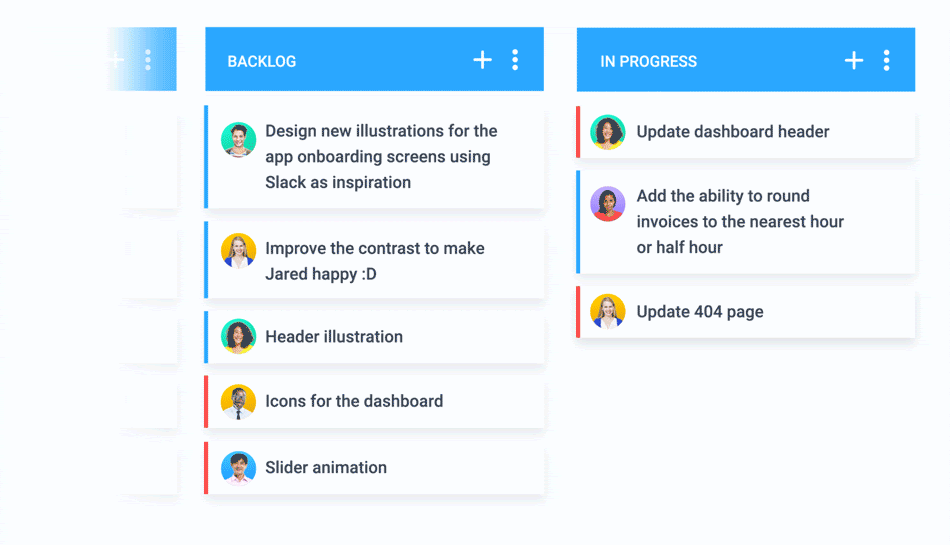
Once you’ve set that up yourself, your team members should add their own tasks and place them in the appropriate status. They already created task lists so this part should be relatively easy.
As you all adjust, you’ll find things that you missed and add them over time. New projects and tasks should be added to the software immediately.
Use your project management tool to communicate priorities, check for updates, and keep files organized.
It will take practice to get used to working from a task management tool, but you’ll all get better with practice. Keep reminding your team to work from the task list and post regular updates. It will become the natural way to work and you’ll wonder how you got anything done before.
What to look for in project management software
Whether you hire a project manager or handle it yourself, task management is a lot easier with dedicated software. There are too many shifting priorities and changing tasks to keep track of everything manually.
You don’t have money to waste.
Your project management tool needs to make a real difference in your ability to get things done, and the price tag needs to make sense. The wasted hours you get back should offset the cost.
Fortunately, most good tools make it easy to scale. You can often start with a free version at the early stages of your startup and grow into a more comprehensive plan as you manage more projects and people.
If this is your first time using project management software, give yourself time to learn. A tool alone doesn’t make the difference. You have to build the right habits to get the results you want.
With that in mind, here’s what to look for in a good tool.
Task Management
One of the primary functions your project management software should serve is to help you organize, assign, and track tasks.
Choose a tool that allows you to organize projects and workflows according to your chosen project management style. If you use Scrum, for example, you should be able to organize work into sprints. For Kanban, your software should let you create cards and track workflows on a Kanban board.
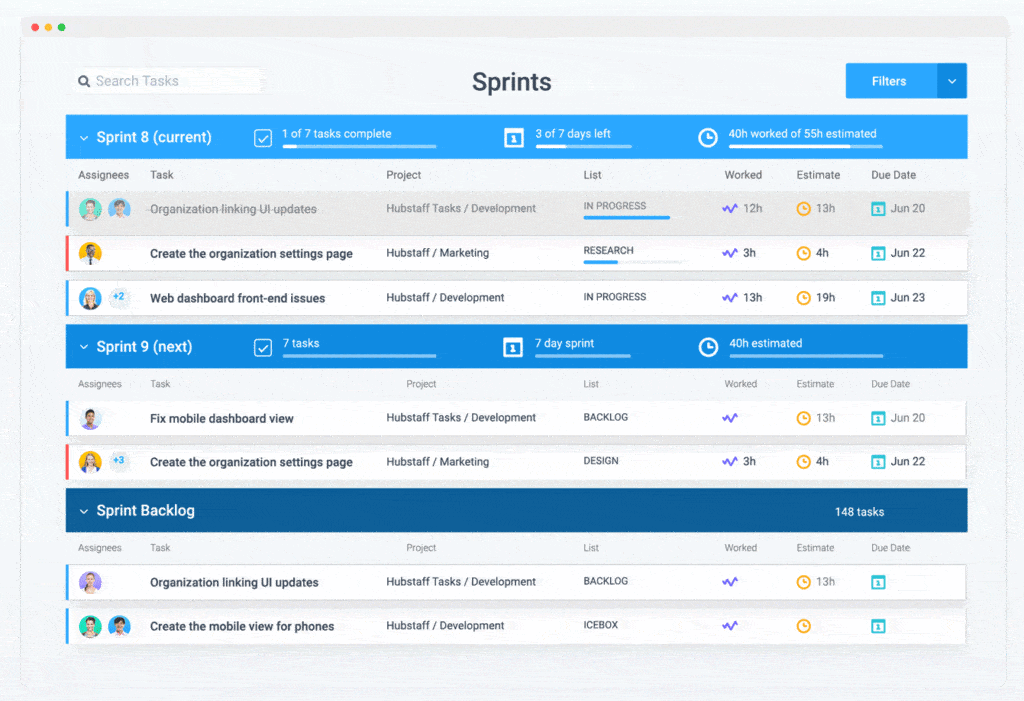
Your team will use task cards to keep track of what has already been done and decide what to do next. Make sure that your project management software keeps information organized and easy to find.
Tasks should include:
- A place for a detailed description
- Assignees or user roles
- Comments
- Attachments
- Time tracking information such as estimated time and time worked
- Due dates
- Checklists or a similar way to further break down work
- Workflow information such as the current status and next steps
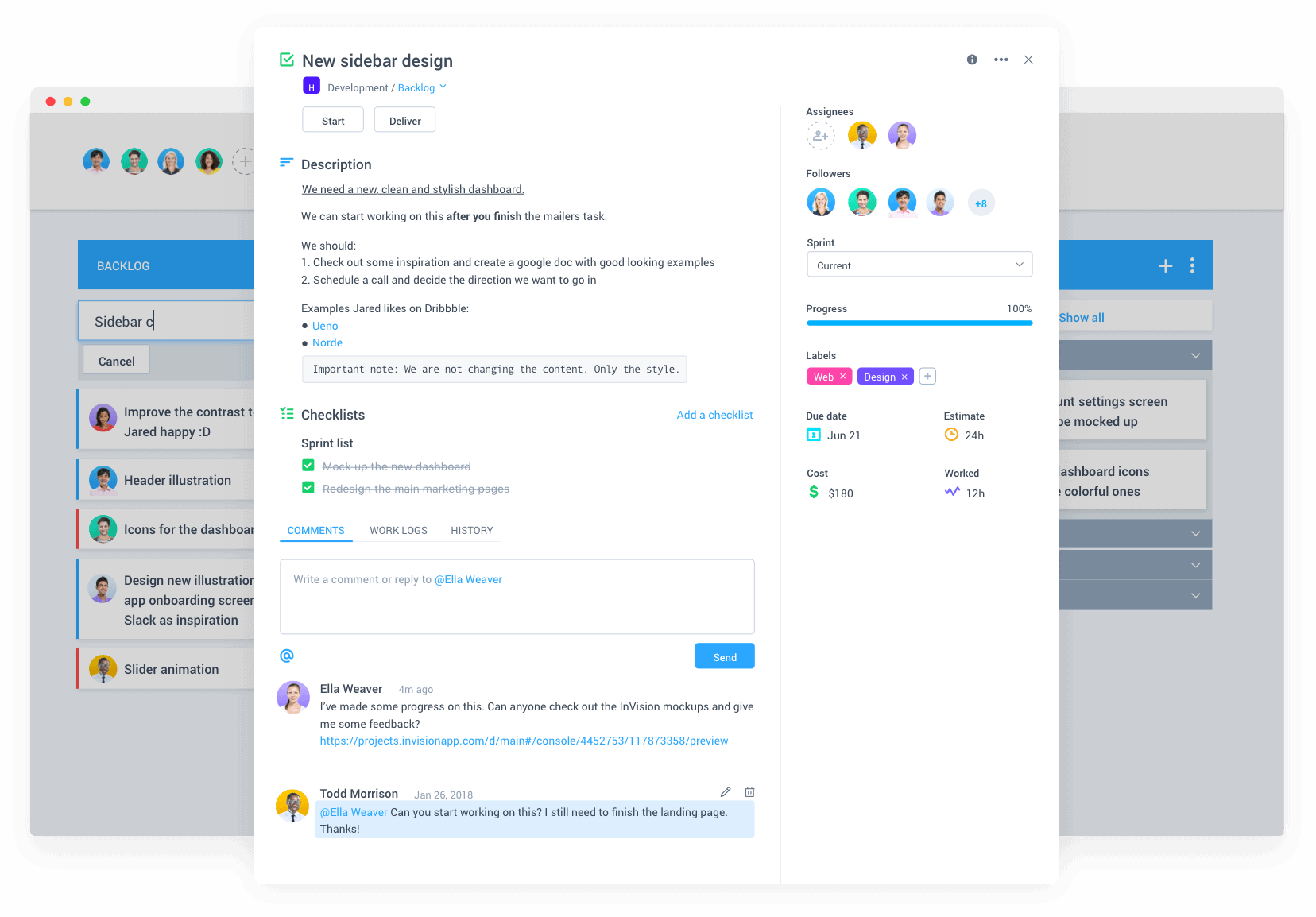
Standups
Standups help your team stay in the loop. Every day, each team member gives a quick update covering:
- What they worked on
- What they plan to do next
- Any blockers or things they need to get their work done
Look for a project management tool with automated standups. These prompt your employees to give a quick update at the end of the day so you can stay connected, even when you work asynchronously.
Automated standups are a huge time saver. In-person standups are supposed to take 15 minutes or less, but they often run way longer.
Instead of interrupting productive time for an update meeting, use your project management software and let your team give their update at a logical stopping point.
Workflows
Your team tackles different types of projects in different ways. Your project management tool should be able to adjust accordingly.
Workflows control what steps a task goes through before completion and who’s in charge at each. When one step is finished, the task is passed to the next person.
Setting up all your flows manually can be a pain. Look for a tool that includes templates to help you get started faster. You should be able to customize those templates to suit the way your team works or set up a new flow from scratch if you want.
Automation isn’t a requirement, but it’s nice to have.
An automated workflow assigns tasks to the right people and sends alerts to team members when there’s an update.
This is especially helpful when you’re adjusting to your new project management process. Your team will miss fewer things because they don’t have to think about the hand-off.
Time Tracking
When you need to be as efficient as possible, time tracking is a game changer.
Choose a project management tool that allows you to track time to specific tasks. The data will show you exactly what your team works on and which projects take the most resources.
Tracking time by task is easy to do. Ask your team to switch the timer whenever they switch tasks so you get the most accurate data. It’s a simple thing, but it has a huge impact.
Starting and stopping the timer focuses your attention on the task at hand. If you want to try a productivity technique like timeboxing, this is a great way to do it.
Most importantly, your time tracking data will show you where you might have problems that need to be addressed. You’ll be able to see the tasks that are eating up your team’s time and fix issues before they drain your bank account.
Integrations
You have more than one tool in your tech stack. When you look for a new program, it’s important that it can talk to the other things you already use.
Of course, just because you use a piece of software frequently doesn’t mean it has to connect to your project management system. There’s no reason that your graphic design programs or development tools need to connect to your task management software, for example.
However, it’s very useful to get task updates via email or Slack. Those integrations make your project management tool more powerful.
If you already use any tools for task management like to-do list software or a time tracking app, choose a project management tool that integrates with those programs. You’ll save more time when your tech ecosystem plays nicely together.
You might be able to replace some of your existing tools entirely if your new software has the right features. Even if an integration is available, thoroughly review the feature list to see if you can save time and money by centralizing your project management in a single tool.
Hubstaff Tasks is perfect for your startup

Hubstaff Tasks is a powerful tool that covers all your project management needs. Manage tasks on Kanban boards, by sprints, or in the timeline view to suit the way you work.
This project management tool leverages the best parts of agile to be as efficient and flexible as possible. Automated features like workflows, standups, and communication features save time and money.
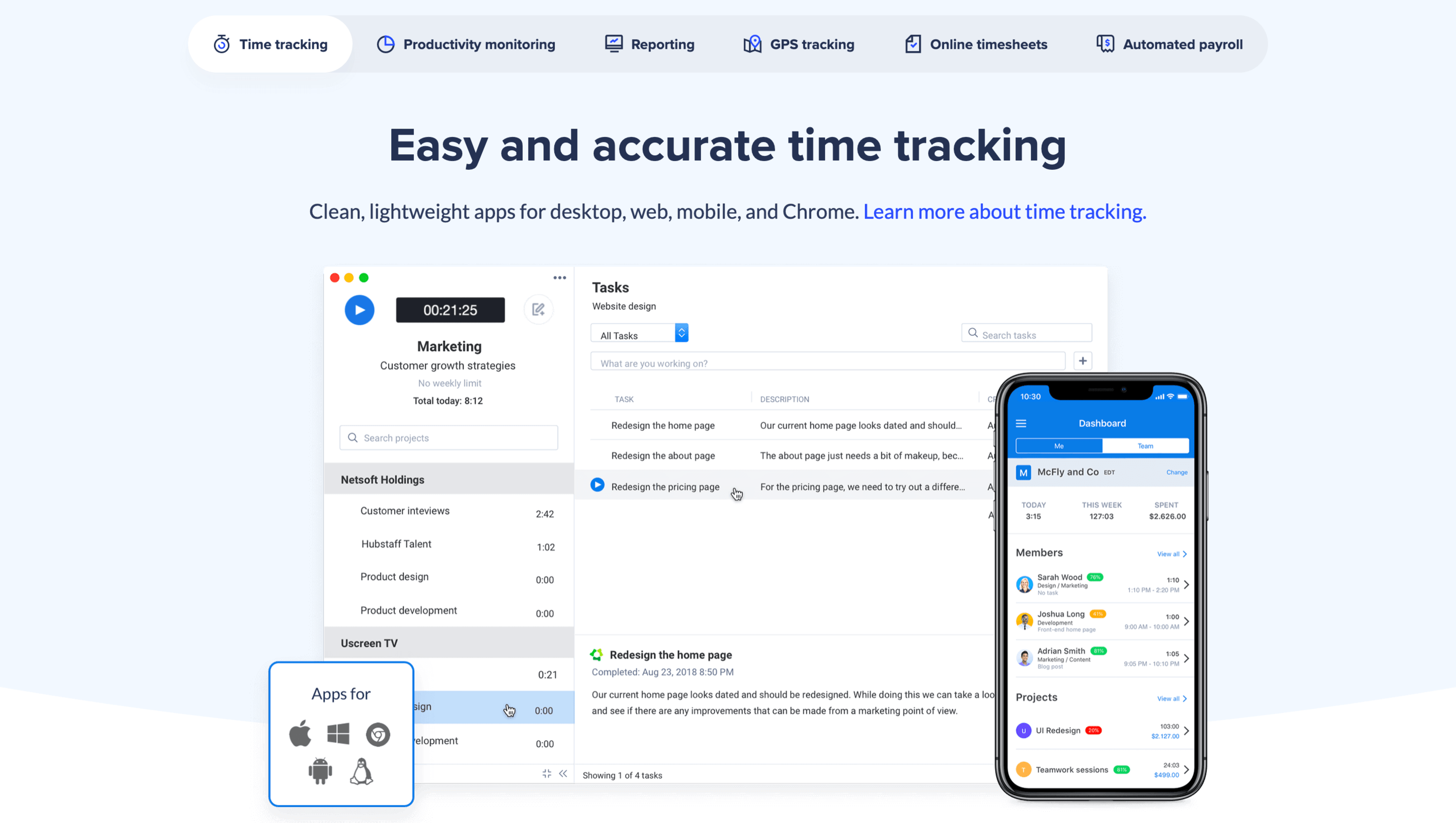
Add time tracking and boost your productivity with Hubstaff.
Hubstaff and Hubstaff Tasks work together seamlessly to help your startup get more done in less time.
Key Takeaways
Startups that master project management are better equipped to succeed.
Remember that this is an ongoing process, not a one-time task. Aim for constant improvement. Taking a gradual approach makes it easier for your team to adjust.
Hiring a project manager is a great move, but if it’s not within your budget, that shouldn’t stop you. You can manage your own projects successfully with a little discipline.
Bookmark this post so you can refer back to it as you get started. Here’s what you should do right now:
- Take inventory. What tools do you already have to help you manage projects effectively?
- Start a free trial or sign up for a free version of a project management tool like Hubstaff Tasks. Use this tool to start organizing the projects you’re already working on.
- When you have all your projects listed, start mapping out your workflows. Ask your team for help. Before you can improve your processes, you should understand how your team works now.
- Choose one workflow or process to improve. Remember — consistent and gradual improvements are more likely to stick and easier to do.
Looking for more resources on some of the topics discussed here? Here are a few to get you started:
The Best Project Scheduling Software in 2021
Why You Need To Start Resource Planning, and How To Do It Well
Subscribe to the Hubstaff blog for more posts like this
Most popular
The Critical Role of Employee Monitoring and Workplace Security
Why do we need employee monitoring and workplace security? Companies had to adapt fast when the world shifted to remote work...
15 Ways to Use AI in the Workforce
Whether through AI-powered project management, strategic planning, or simply automating simple admin work, we’ve seen a dramatic...
The AI Productivity Panel: Lessons From Leaders on What’s Working (and What’s Not)
When I moderated this AI productivity panel, I expected a solid conversation. What I didn’t expect was the flood of real-world i...
Employee Performance Dashboards: Templates, Tools, and Best Practices
Keeping track of how your team’s really doing can be tricky. Spreadsheets pile up, one-on-ones only tell part of the story, and...






